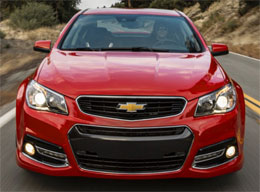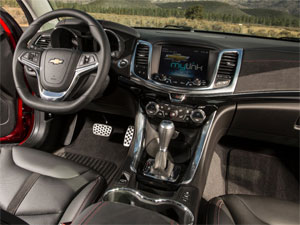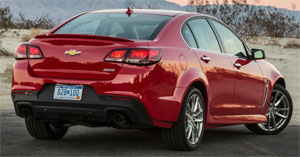2014 Chevrolet SS
It’s been 18 years since Chevrolet has offered a rear-wheel-drive sport sedan in their line-up. But it’s not like GM was out of the game entirely, they just left such drivetrains to Cadillac and Pontiac, not to mention their Australian Holden brand, which is where the 2014 Chevrolet SS comes from. Well after a brief fact finding mission, here’s our scoop on the General’s new “rear” admiral.
Yes, Chevrolet is back in the rear-wheel-drive performance sedan business! And you don’t have to be a fan of NASCAR to be excited about that, as with the 2014 SS the bowtie brand now has a fresh and complete suite of high-pro offerings from the all-new Corvette to the refreshed Camaro, and even the small but potent Sonic RS.
The SS joins the Chrysler RWD duo of Charger and 300, and while that’s a small competitive set, we think GM has their sights on loftier competition like European sport sedans. As like other recent GM cars, the SS spent significant development time on the Nurburgring.
And it didn’t take us long, while driving through the many sweeping corners near Palm Springs, California to find the SS’s near perfect balance very rewarding. It is a big car, yet weighs in at under 4,000-pounds. We found the nose a tad heavy; still it felt precise, like driving a 4-door Camaro with better forward visibility.
 And that makes sense, since both SS and Camaro are based on Holden Commodore architecture from GM Australia; and since an SS was in the works from the beginning, there’s been no Americanization compromise.
And that makes sense, since both SS and Camaro are based on Holden Commodore architecture from GM Australia; and since an SS was in the works from the beginning, there’s been no Americanization compromise.
Much like the Camaro, rear visibility is not so great, with a huge deck lid spoiler in your rear view mirror.
This chassis was also under the short lived Pontiac G8, but has been updated since then; and now has belt-driven variable assist electric power steering. While there’s nothing high tech about that, we found it very dialed in with quick response, though even more feel would be nice.
But, while the SS’s firm suspension is great in the twisties, it gets tiresome on the highway. Better seats would help, as would GM’s Magnetic Ride suspension which is not available. All SS’s wear a limited-slip rear and a 6-speed automatic that we found a little slow on response when left alone, unless in Sport mode. Better to use the standard paddle shifters.
Natch, there’s GM small-block power burbling under the hood. An LS3 6.2-liter V8 with nice level numbers of 415-horsepower and 415 lb-ft. of torque. Exhaust gives a nice bark, but inside it remains quiet, which can be good or bad depending on what’s music to your ear. 0-60 time is right at 5.0 seconds.
 Inside, things are more sport than luxury; with plenty of SS logos, red stitching, and chrome dash trim. Gauges are equally sporty, featuring the familiar GM deeply hooded twin dial setup with color info screen in between; only hoods are round versus the Camaro’s squarish corners. A color Head Up Display is standard.
Inside, things are more sport than luxury; with plenty of SS logos, red stitching, and chrome dash trim. Gauges are equally sporty, featuring the familiar GM deeply hooded twin dial setup with color info screen in between; only hoods are round versus the Camaro’s squarish corners. A color Head Up Display is standard.
Back seat space and comfort are the real strong points here; as seats are large and well padded, offering great comfort for 2 or 3 in a pinch. There’s also good cargo space in the trunk at 16.4 cubic-ft. Chevrolet’s MyLink with 8-inch touch screen display includes standard navigation, and the SS is the first Chevrolet to feature Automatic Parking Assist.
Exterior design is testosterone filled with a muscular nose-down stance, flared out fenders, and staggered 19-inch wheels with 245/40 rubber up front, 275/35 in the rear. Though the friendly new Chevrolet face keeps this Super Sport from being too aggressive. HID headlights and LED running lights are standard.
Fuel Economy is more old school muscle car than modern sport sedan with Government Ratings of 14-City, 21-Highway, and 17-Combined. That means a Gas Guzzler tax and a poor Energy Impact Score of 19.4-barrels of annual oil use and 8.9 tons of CO2 emissions.
The SS is truly an international affair, being built in Australia, developed in Germany, with a big Detroit designed power V8 that’s actually assembled in Mexico.
 Fortunately, pricing is simple as there are very few options and just one model of SS starting at $45,770. That’s very close to an SRT8 Charger sedan.
Fortunately, pricing is simple as there are very few options and just one model of SS starting at $45,770. That’s very close to an SRT8 Charger sedan.
It truly is great to see Chevrolet return to the full-size rear drive sedan ranks. And while the SS is fun that we enjoyed more than we thought we would, it’s not as refined as the Charger, which would probably still be our hot-rod big four-door pick.
Another wrinkle is the unknown future of the SS. GM says it will stop building vehicles in Australia by 2017. Let’s hope the Chevrolet SS finds a new home in our home before then; and perhaps a little more refinement as well, or else it may quickly disappear like the G8. And, that would be a real pity!
Specifications
- Engine: 6.2-liter V8
- Horsepower: 415
- Torque: 415 lb-ft.
- 0-60 mph: 5.0 seconds
- EPA: 14 mpg city/ 21 mpg highway
- Energy Impact: 19.4 barrels of oil/yr
- CO2 Emissions: 8.9 tons/yr
2025 Infiniti QX80
Infiniti’s Flagship SUV Sets A Course For Extravagance
This full-size Infiniti QX80 started out as the QX56, a hastily rebadged version of Nissan’s truck-based Armada full-size utility. That was in the early 2000s when the luxury SUV craze was exploding. It wasn’t as much as a game-changer, as it was “try to keep upper”. Now, this new QX80, Infiniti is promising to “Reimagine the luxury SUV”. Let’s see if Infiniti has turned their imaginations into reality.
Well, if over the top is what Infiniti was shooting for in the all-new 2025 QX80, mission accomplished. There’s an overall feeling of extravagance here that we haven’t experienced from Infiniti in quite some time.
It’s not just the open pore ash wood trim with aluminum inlays, 24-speaker audio, and plush quilted leather seating; there’s also nicely integrated ambient lighting, a massive glass roof, plenty of tech, lots of active driving assistance, and even chilled center console storage. Forward of that is a dual touchscreen setup; the top 14.3-inch touchscreen for infotainment sits next to the digital gauge display in a single housing; while just below, there’s a 9-inch one for climate controls.
You are reminded this is still a body-on-frame utility the moment you have to climb up into the cockpit, but there’s also the commanding view of the road that comes with that. Captain’s chairs are standard for the second row, but a three-place bench is optional with all trims except for top Autograph which comes exclusively with these climate-controlled massaging chairs, along with a touchscreen control panel. The third-row experience is great, too, with heated leather seating, and adult size room for three.
Now, there is a whole new experience coming from under the hood. The last gen’s V8 has been replaced with a new twin-turbo 3.5-liter V6 rated at 450 horsepower, 50 over the V8. More notably, torque is up by more than 100 lb-ft to 516. Transmission is a nine-speed automatic, two more gears than last year, with rear-wheel drive standard, four-wheel drive an option. Max tow rating is 8,500-lbs.
And at the test track, it did pull strongly off the line, getting up to speed in a hurry with the 0-60 sprint taking just 6.3 seconds. There is roughly 3 tons of weight to push through the quarter-mile, but that twin-turbo does it well, finishing in 14.7 seconds at 95 mph. Gear changes are incredibly smooth, while not hindering acceleration in any way.
It's an impressive looking utility from any angle.
In panic braking runs, there was some fade and a considerable amount of nosedive, but our average stopping distance of 115 feet is not bad for a vehicle as big and heavy as the QX80. Last gen, the QX80 moved from the Titan truck platform to the global Patrol SUV chassis, which shifted the vibe from budget Escalade to Lexus LX fighter. The attending improvement in ride and handling was the real bonus, and that largely continues for this gen with air suspension and Dynamic Digital Dampers on all but base QX80s. While we could certainly feel all that weight through our cone course, body roll was well-controlled and without significant oversteer or understeer.
It’s an impressive looking utility from any angle, starting right up front with the big “bamboo forest” grille. The overall shape is boxy, but all body panels are smooth; and for better or worse, Infiniti joins the flush door handle fad. Look for its “Artistry In Motion” design theme to work its way down through the rest of the Infiniti lineup. All QX80s ride on 22-inch wheels except for base Pure trim which makes do with 20s.
A full power play includes standard motion-activated rear liftgate and power operation of both second and third row seats, expanding cargo capacity from 22 cu-ft behind the third row to 59 behind the second, and a max of 101.0 cu-ft with both rows folded.
Government Fuel Economy Ratings with four-wheel-drive are not great: 16 city, 19 highway and 17 combined. We averaged 18.6 mpg of premium. That’s a much worse than average Energy Impact Score, using 17.5 barrels of oil annually, with 8.6 tons of CO2 emissions.
Driving such a PUREly LUXEurious SENSORY overload, you’ll probably be expecting people to want your AUTOGRAPH, which we’re guessing is how Infiniti came up with their grade structure; pricing starts with Pure at $84,445 and climbs to $112,590 for Autograph.
The 2025 Infiniti QX80 is a massive SUV that delivers massive amounts of power and luxury. They aimed for the moon here and have clearly blasted themselves into a much more competitive orbit in the big buck, big hauler, sport-utility galaxy.
Specifications
As Tested
- Engine: 3.5-liter twin-turbo V6
- Transmission: 9-speed automatic
- Horsepower: 450
- Torque: 516 lb-ft.
- EPA: 16 City | 19 Highway | 17 Combined
- 0-60 mph: 6.3 seconds
- 1/4 Mile: 14.7 seconds at 95 mph
- Braking, 60-0 (avg.): 115 feet
- MW Fuel Economy: 18.6 mpg (Premium)
2025 Honda Civic Si & Hybrid
More Fun, More Refinement, More Civic
If you’re looking at buying a Honda Civic Si instead of a standard Civic, chances are, you’re the kind of driver that actually enjoys being behind the wheel and wants a fun-to-drive car that injects some pure enjoyment into your daily grind. Well, good news! There’s an updated Civic Si that promises to deliver more fun and refinement than ever!
The 2025 Honda Civic Si spearheads a revised Civic lineup that also sees the return of a Hybrid to the roster, something that’s been missing since 2015. This 11th-gen Civic first arrived for 2021, and gets a slightly more aggressive look for ‘25 with an updated front fascia and grille.
And while it remains available as either a four-door sedan or five-door hatchback, the Si comes only as a sedan with a hex pattern grille, gloss black trim and aero enhancements, both up front and in the back, with a decklid spoiler. Other Si upgrades include larger brakes and 18-inch V-spoke wheels for the optional summer performance tires.
Honda claims the chassis has been stiffened and the suspension retuned for 2025; and it certainly makes for a fun driving little car, though it’s hard to call this current Civic little anymore, as dimensions and interior space are more midsize these days. Under the Si’s hood is Honda’s tiny but mighty 1.5-liter turbo-four engine, furiously spinning up its 200 horsepower and 192 lb-ft of torque. The Si comes exclusively with a six-speed manual transmission with a miniature shift knob and very light clutch enhancing its definitely playful vibe.
At our test track, once we got some heat in the front tires and figured out the best traction control settings, we were able to rip off consistent 6.9-second runs to 60. Not crazy quick, but the free-revving engine and manual trans made for a totally engaging experience. Our best quarter-mile, 15.1 seconds at 94 mph. But it was in our handling course where the fun really jumped up, slicing through the cones like we were in a video game. Yet it also felt well planted the entire time, grip was plentiful, and body roll minimal. Consistency, too, in braking runs, repeatedly stopping in a mere 92 feet from 60 mph.
Our handling course [is] where the fun really jumped up, slicing through the cones like we were in a video game.
No matter which Civic you choose, you’ll get plenty of standard content, including auto climate controls and illuminated steering wheel controls, plus more color choices for ’25. The funky lattice-style dash trim carries over, the Si getting racy red accents and manually-adjusted cloth seats that definitely are sporty. While over in the Hybrid, things take a classier turn with Sport Touring getting leather-trimmed seats, the 9-inch version of their touchscreen infotainment setup with Google built in, a 10.2 digital instrument cluster, 12-speaker Bose audio, and wireless phone charging.
Following Honda’s current marketing strategy, the returning Hybrid will be available in upper trims only, specifically Sport and Sport Touring. It uses a combination of naturally aspirated 2.0-liter I4 engine and Honda’s Two Motor Hybrid system for a 200-horsepower total. Yes, that’s exactly the same as the Si, and the Hybrid setup out-torques bigtime with 232 lb-ft, 40 more than the Si.
The hatchback’s Government Fuel Economy Ratings are 50 city, 45 highway, and 48 combined. We only managed to wrangle 43.5 mpg of regular in our wintertime driving loop.
The Sedan’s numbers are a little better than the hatchback’s; and while that additional fuel economy is great, with all of that torque, the new Civic throws it back to the original Accord Hybrid, having a bit of a performance bent to it, including a Sport Drive mode that heightens throttle response and tightens up steering. It also gets a unique gauge display and active sound inside the cabin. There are also four levels of regen braking with shifter-style adjustment paddles on the back of the steering wheel. And unlike the Si, you can get the Hybrid as a five-door hatchback, which most of our staff really enjoy looking at and everyone can appreciate its 24.5 cu.-ft. of cargo space and folding seatback flexibility.
Civic pricing starts at $25,400 for a base LX sedan. Hybrids start with Sport Hybrid at $30,100. The hatchback is a bit more at $31,300. Si comes in at $31,400, just below the range-topping Sport Touring Hybrid at $33,100.
While at times the Civic has been more of a blank canvas that buyers could customize to make it their own, this 11th-gen already offers something for just about everyone, whether you’re a high-revving gear shifting driving enthusiast, a luxury-minded fuel sipper or something in between. The 2025 Honda Civic is the total package. One high quality, not-so-small car that delivers more fun and more refinement than ever.
Specifications
Civic Si
- Engine: 1.5-liter turbo-four
- Transmission: 6-speed automatic
- Horsepower: 200
- Torque: 192 lb-ft
- 0-60 mph: 6.9 second
- 1/4 Mile: 15.1 seconds at 94 mph
- Braking, 60-0 (avg): 92 feet
Civic Hatchback Hybrid
- Engine: NA 2.0-liter I4
- Transmission: eCVT
- EPA: 50 City | 45 Highway | 48 Combined
- Horsepower: 200
- Torque: 232 lb-ft
- MW Fuel Economy: 43.5 mpg

































































































































